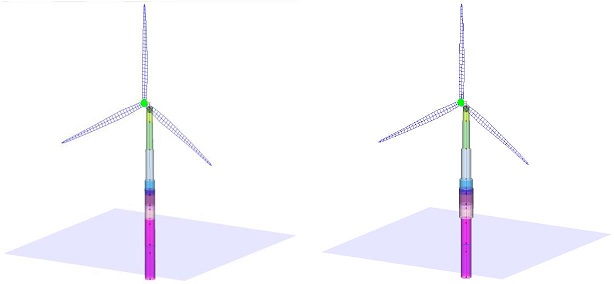
◀ Back to projects overview P201204-003-ECN
Application of Advanced Design Tools to a 3 bladed offshore wind turbine
This project aims at reducing the cost of offshore wind energy by means of developing cutting-edge tools for controller design, analysis and automated integral design. The objectives are:
- To apply ECN’s Advanced Control design Tool: ACT to design a controller for XEMC Darwind’s wind turbine XD115 and verify by experimental tests.
- To demonstrate the achievable cost reduction of an automated integral design approach for the support structure, and
- To develop and verify advanced integrated design tools for increased accuracy in load predictions.
Results obtained
The three objectives in the project are rather self-contained, and therefore the approach and results are described below per objective.
Control tool development:
ECN developed and verified a software tool for the design of cutting-edge industrial wind turbine controllers, that achieve an optimal balance between maximal power yield and minimal loads. The newly developed software Advanced Control design Tool (ACT) includes control algorithms for:
- Reducing fatigue loads on the main turbine components (blades, tower, drive-train, nacelle, hub and yaw system)
- Reducing the number of shutdowns due to strong wind gusts (power production increase)
- Reduction of extreme loads on tower and blades due to failures (loss of grid connection, failures in pitch mechanism)
These algorithms, and additional advanced functionality, have been implemented into ACT, and the resulting controllers have been extensively verified numerically and experimentally (see Section 2).
As a highlight of the controller development output:
The ACT controller is implemented on the XD115 prototype situated at ECN’s test site in Wieringermeer, and tested in accordance with IEC standards, and compared to the measurements during operation of the original XD115 controller. A comparison study has been performed by XEMC Darwind [7], indicating that the application of ECN controller decreases damage equivalent blade root loads for the turbine lifetime with approximately 20.1%.

Figure 1: Measurement results for blade root loads, applying original XEMC Darwind controller (blue) and ECN new designed controller (red)
Integral design:
The wind turbine design tool FOCUS6 [15] has been extended to enable an automated integral design of the support structure and tower. To this end, an optimization procedure is set up that iteratively updates the structural parameters and subsequently fine-tunes the wind turbine controller to keep up optimal performance with respect to the tower fatigue loads. The resulting configuration is checked against ultimate load constraints (maximum allowable stress and buckling) and fatigue damage constraints. This new functionality of FOCUS6 is used to perform integral support structure design for the XD115 offshore wind turbine. The optimization achieved 21.7% reduction of the support structure mass compared to a baseline support structure based on a representative monopile as used in the OC3 project. This optimized support structure configuration still complies with the constraints on stress, buckling and lifetime fatigue damage.

Figure 2: The optimized tower has about 16% larger diameter, but around 60% less thickness!
Design tools development:
The accuracy of the currently used state-of-the-art tools for loads analysis of drive train, yaw system and pitch system do not suffice and more detailed modelling is necessary. However, since too detailed modelling could be prohibitive due to unacceptable calculation times, knowledge and experience is necessary on achieving an optimal balance between the accuracy of the loads prediction and the computational effort. Improved design tools will increase the reliability of the loads predictions and reduce the design uncertainty (safety factors), leading to material costs’ savings.
A large number of load calculations have been performed using aerodynamic models with different complexity, and the subsequent analysis offers new insights in the computational results for blade deformations and loads (see Section 2).
Contribution to FLOW targets
This project contributes to the reduction of the overall cost of energy by influencing the capital expenses (CAPEX), O&M costs, and the energy production.
CAPEX are reduced by saving on material costs. This is achievable due to the reduced extreme and fatigue loading on the main wind turbine components, as realized by the new control tool ACT. Furthermore, the improved design tools enable a more accurate prediction of loads. The resulting reduction of design uncertainty enables reduction of the safety factors used in the design, and therefore material costs savings. Finally, the integral support structure design approach deliver another (direct) contribution to lowering the loading and with that the material costs.
O&M costs are lowered more indirectly by the results of this project. By reducing fatigue loads on the main components, the controller effectively reduces the damage induced by structural vibrations. This decreases the failure rates and, consequently, unplanned maintenance costs. An additional contribution to the O&M cost reduction is given by the increased reliability of the loads predictions, achieved by the improved design tools.
Finally, the energy production is also expected to increase, primarily due to the reduction in the number of failures of mechanical components, and thus overall reduction of the downtime.
Applying all these effects combined in future designs could result in a reduction of almost 5% of the LCoE.
Partners involved
- ECN
- WMC
- XEMC Darwind
Contact details
Mr. Toine Curvers
Project documents

 Share this page
Share this page
